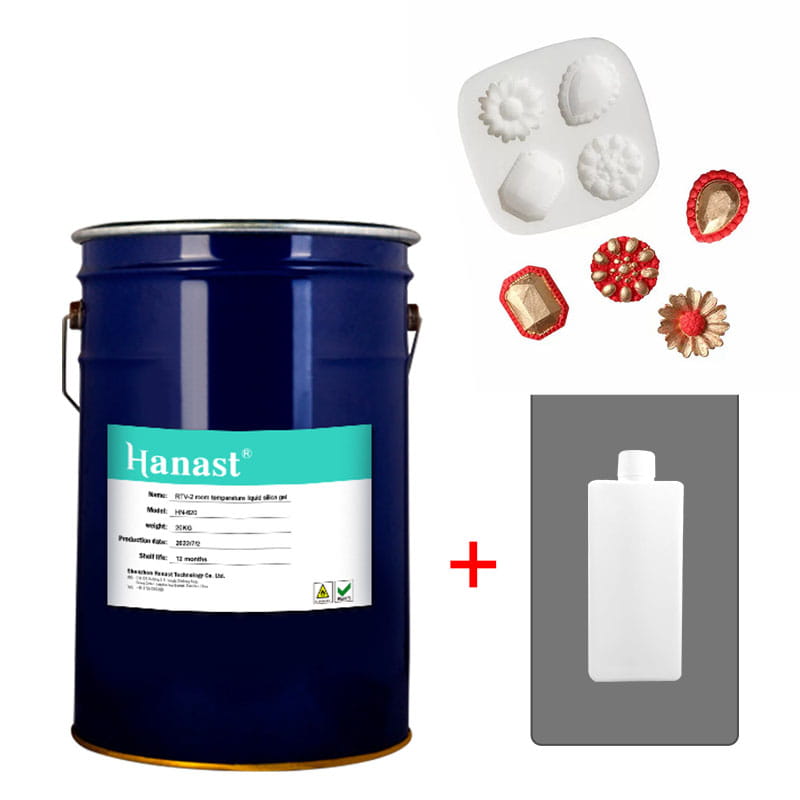Introduction to gypsum mold silicone
 Apr 28,2023
Apr 28,2023

 Hanast
Hanast
Introduction to gypsum mold silicone
Gypsum mold silicone is also a type of ordinary liquid silicone, with two components. Component A is silicone and Component B is curing agent. The two can be solidified and formed by mixing them in a certain proportion. Silicone molds made with higher hardness will also have higher hardness, making them less prone to being crushed and deformed by the weight of cement during the process of turning cement. They have better tear resistance. Moreover, silicone molds have a certain degree of elasticity, therefore, silicone molds are the best mold material for flipping cement products.
Introduction to gypsum mold silicone:
Hongye brand gypsum mold silicone is a two component liquid silicone that can be cured at room temperature or at elevated temperature. Before curing, both silicone and curing agent are liquid, and when mixed together, they will solidify into silicone elastomers. Therefore, silicone mold is the most elastic mold material among all molds, and gypsum products themselves are fragile and fragile. Using silicone mold to flip the mold not only does not damage the structure of gypsum products, It can also perfectly replicate the fine patterns of gypsum products, making it the preferred turnover material for gypsum cement products.
The main application areas of gypsum mold silicone are:
Cement gypsum mold silicone can be mainly used for the production of various gypsum lines, gypsum boards, gypsum buildings, decoration process parts, Roman columns, cement products, cement rockeries, cultural stones, artificial stones, gypsum cement products, and other silicone molds.
Performance characteristics of gypsum mold silicone:
1. Good fluidity, easy to pour, easy to operate, easy to demould without damaging the product's grain structure;
2. Good tensile strength and high tearing strength make the silicone mold very durable. By replicating some simple gypsum products, the mold can be turned over thousands of times;
3. The mold produced is not deformed, resistant to high and low temperatures, aging, and does not swell;
4. Good weather resistance, acid and alkali resistance, low linear shrinkage rate (≤ 0.3%);
5. Room temperature rapid curing, hardness, viscosity, operating time, and curing time can be customized according to customer product requirements.
Instructions for using gypsum plaster mold silicone:
This product is liquid silicone rubber, with two components. Component A is liquid silicone and Component B is silicone curing agent. Mix and stir the AB components in a fixed proportion, and they can harden within a few hours. The silicone mold can be solidified and formed.
The ratio of silicone rubber for condensation molds is 100:5, while the ratio of silicone rubber for addition molds is 1:1 and 10:1. Please confirm with the manufacturer.
Selection method for gypsum mold silicone:
1. Products with scales ranging from 10 to 20 centimeters have very precise markings, and can be molded using silicone with a hardness of 10 to 20 centimeters;
2. For products with a scale of 30-50 centimeters, the markings are not very complex, and can be molded using silicone at 20-30 degrees Celsius;
3. Products with a scale of over 60 centimeters and very precise markings can be brushed with silicone at 30-40 degrees Celsius.
Precautions for gypsum mold silicone:
1. The amount of curing agent added should depend on the temperature, and should be reduced when the temperature is high. Excessive use of curing agents can cause the mold to become hard and brittle; If too little curing agent is used, the operating time will be prolonged.
2. In order to achieve the best application effect of your silicone mold, please store the mold for at least 24 hours before use




 Home
Home




 Is thermal grease insulating? How to use thermal grease correctly?
Is thermal grease insulating? How to use thermal grease correctly?  You May Also Like
You May Also Like







 Tel
Tel
 Email
Email
 Address
Address












